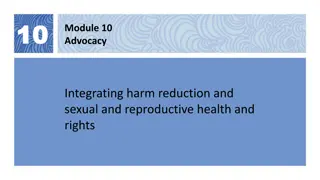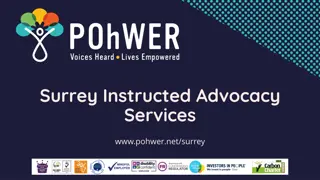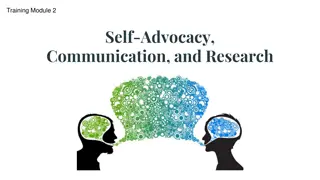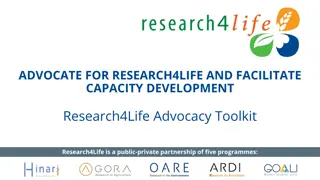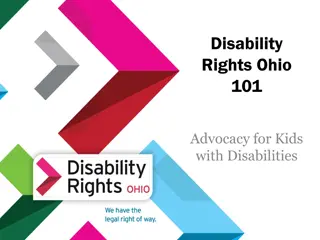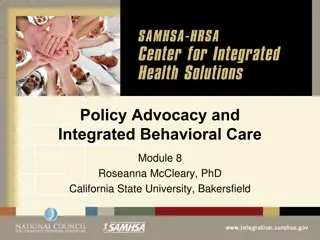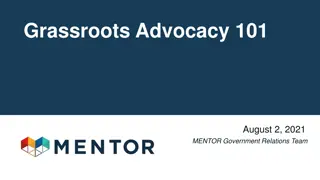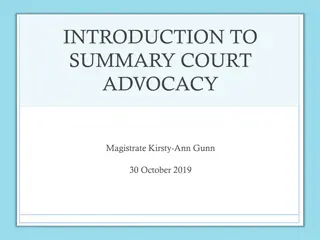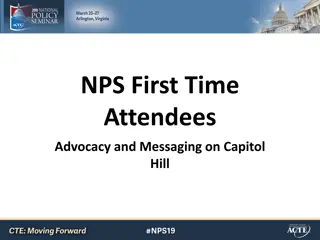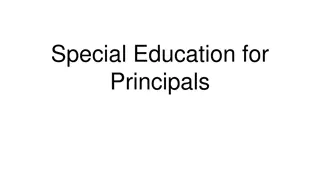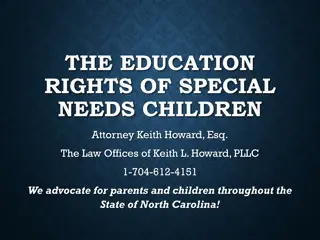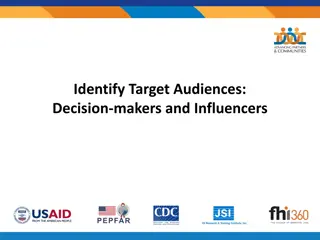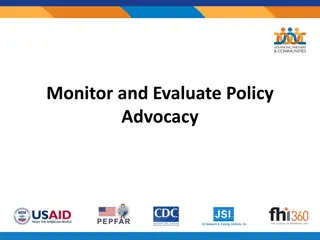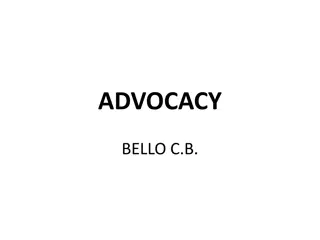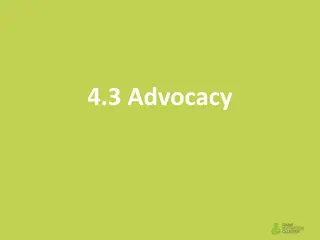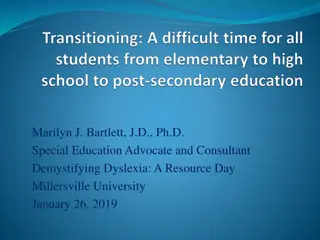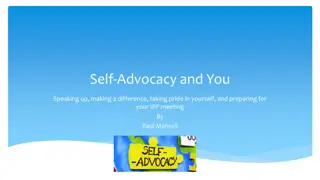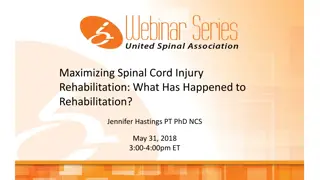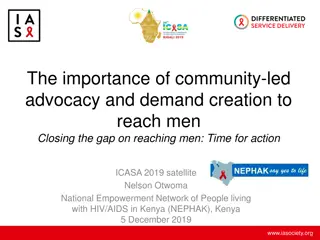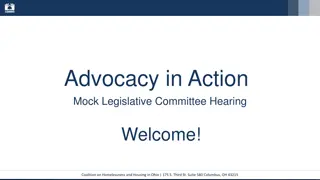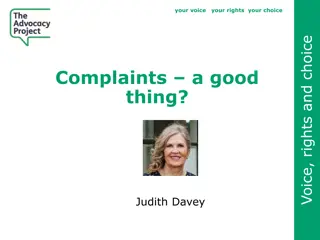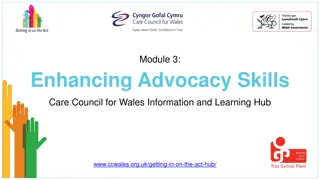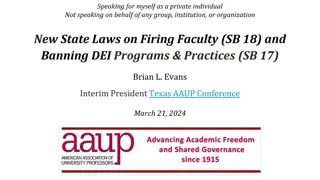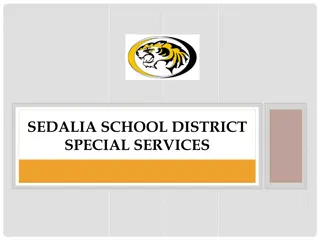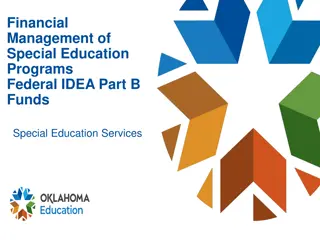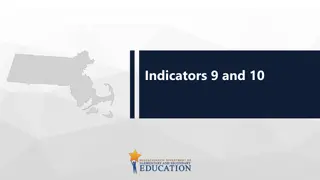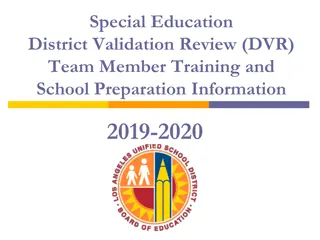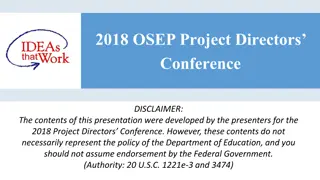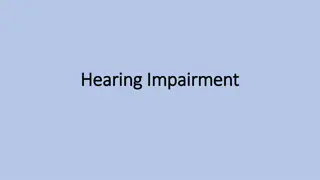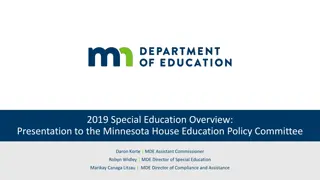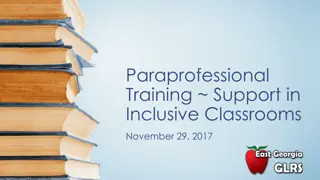Understanding Special Education Advocacy
Special education advocacy is vital for children with disabilities to receive appropriate education services. This includes understanding what special education entails, who can make education decisions, warning signs for assessments, IEP meeting preparation, available services, and the truth about children who need an IEP. Knowing the legal authority concerning education decisions and rights holders is also crucial in ensuring children receive the necessary support for their unique needs.
Uploaded on Sep 16, 2024 | 0 Views
Download Presentation

Please find below an Image/Link to download the presentation.
The content on the website is provided AS IS for your information and personal use only. It may not be sold, licensed, or shared on other websites without obtaining consent from the author. Download presentation by click this link. If you encounter any issues during the download, it is possible that the publisher has removed the file from their server.
E N D
Presentation Transcript
SPECIAL EDUCATION ADVOCACY Presented by: Karen Martinez-Chung, Esq. Education Program Attorney Elana Zada, Esq. Education Program Attorney
Overview What is special education? Who has the authority to make education decisions ? What are the warning signs that a child might need special education? How does one request a special education assessment? Preparing for the IEP meeting What are the components of an IEP? Determining eligibility for special education What kinds of classrooms are available for kids with IEPs? What kinds of special education services are available?
The Truth About Children who Need an IEP All children develop and learn in different ways. Being eligible for special education services does not mean that the child is dumb or cannot learn. It means the child learns in different ways, and/or needs specialized services to assist with their learning.
Special Education Program Children with disabilities have a right to special education and related services. An education program that is individualized to meet the child s unique needs based on their disability. FAPE: Free Appropriate Public Education The disability must prevent the child from benefiting from their education. How young can a child be eligible? As young as 3-years old When do children age out of services? They can continue to qualify for services until they receive a high school diploma or the semester when they turn 22-years old.
WHO HAS THE LEGAL AUTHORITY TO MAKE EDUCATION DECISIONS?
What are education rights? An Education Rights Holder (ERH) has the legal right to make education-related decisions for a child, including: Requesting records, Requesting special education assessments, and Consenting to special education services and placements in the Individualized Education Program (IEP). An IEP is a contract between the ERH and the school district for special education services.
Who can be an ERH? Biological Parents (from birth) Automatically: Legal Guardians Adoptive Parents With a court order (JV 535 or minute order) Prospective Adoptive Parents Foster Caregivers Relative caregivers CASA Court-trained volunteer If you are unsure who holds education rights, ask the child s court- appointed attorney or social worker.
WHAT ARE THE WARNING SIGNS THAT A CHILD MIGHT NEED SPECIAL EDUCATION?
Signs: Poor grades or attendance Problems with memory or attention Difficulty with classroom activities such as writing, reading or doing math Behavior problems, such as acting out when frustrated or being defiant Social or emotional problems Speech and language problems, such as poor vocabulary, sentence structure, or problems pronouncing words/sounds
Records Request See Handout 1: Records Request
HOW TO REQUEST A SPECIAL EDUCATION ASSESSMENT?
Types of assessments: Psycho-Educational, including: Cognitive/IQ Academic Psychological processing including visual, auditory, sensory motor and attention processing Social, emotional, behavioral Health and physical development including hearing and vision Speech and language by a speech and language pathologist Fine motor and/or sensory processing by an occupational therapist Functional Behavior Assessment
Requesting An Assessment Who can refer a child for a special education assessment? Anyone How do you make the request? The ERH should submit the request in writing. See Handout: Assessment Request What should the assessment request include: Identify the suspected disability (i.e. areas of educational concern) Identify assessments needed ERH contact information, along with a copy of the ERH assignment order, if applicable
Assessment timeline From the date the written assessment request is received by the school, they have 15-calendar days to forward a written response. Assessment Plan It must include all of the assessments requested. If it does not, the school district must forward a written refusal letter addressing the denial of that assessment. Only the education right holder can consent to the special education assessments. The ERH has 15-calendar days to review, sign and return the Assessment Plan to the school The school has 60-calendar days to complete the assessments and convene the Initial IEP meeting from the date the signed assessment plan was received. Written Refusal Letter Specify assessment being denied Reason why the assessment was denied Interventions that will be used in lieu of conducting the assessments
Examples of assessment refusals and rebuttals Assessment refusals: Attendance problems Not being in school long enough/just transferred in from another school Would not be eligible Rebuttals: These reasons can be used to deny eligibility for special education services but only after the assessments have been completed. They cannot be used to refuse testing, as eligibility can only be considered once the assessments are completed.
Assessment Timeline During COVID-19 While SB 117 initially tolled the 15-day timeline for schools to produce an assessment plan or respond after an assessment request is made, this is NO LONGER APPLICABLE as a result of SB 98. What does this mean? School districts continue to have a duty to respond to assessment requests within the 15-day timeline.
IEP Timelines During COVID-19 SB 98 has not waived any of the timelines regarding IEP meetings. Initial IEP Must still be held within 60-days of the signed assessment plan is returned to the school Annual IEPs Must still be held annually when they are due for each child individually despite school closures Triennial IEP/Re-evaluation IEP Must still be held if it's due during physical school closures. ERH Requested IEPs Must still be held within 30-days the written request is sent to the school This includes an IEP meeting you request to discuss distance learning during COVID-19 physical school closures COVID-19 IEP Request Letter
PREPARING FOR THE IEP MEETING
Before the IEP Meeting you should: Request a copy of the assessment reports 5-business days before the scheduled meeting Review assessment reports Discuss the education concerns of the caregiver, mental health professionals and others working with the child Bring a list of questions and concerns to the IEP meeting
WHAT ARE THE COMPONENTS OF AN IEP?
6 kinds of IEPs Initial Determines eligibility for special education. Annual An IEP must be held at least once a year. Triennial Every 3 years, schools must conduct new assessments to determine a student s progress and discuss those assessments at an IEP meeting. Amendment/Addendum The ERH or school can request a meeting at any time to modify an existing IEP. After written ERH request, the IEP must be held within 30 calendar days. 30-Day/Transfer An IEP must be held within 30 calendar days of transfer to a new school district to discuss placement options and services within the new district. District must implement the old IEP and provide comparable services for the first 30 days. Manifestation Determination IEP If a child with an IEP is suspended for 10+ days in a school year or is recommended for expulsion, a manifestation determination IEP meeting must be held. If the behavior was closely related to the disability, no further discipline can happen and the school must conduct a behavior assessment. Schools must notify you of a manifestation IEP. Cal. Educ. Code 48915.5, 56043, 56302.1, 56341.1 1. 2. 3. 4. 5. 6.
Who should attend IEP meetings? Required Members Optional Members Education Right Holder General Education Teacher Special Education Teacher Administrative Designee Any person who has assessed the child or who provides services, if those services are being discussed Parent or current caregiver (if not ERH) School Psychologist Social Worker Other school personnel who provide services or complete an assessment (e.g. speech and language pathologist)
What happens at the IEP meeting? The Written IEP includes 5 main components: Statement of Eligibility Present Level s of Performance Annual Goal s and Objectives Statement of Services Statement of Placement
DETERMINING ELIGIBILITY FOR SPECIAL EDUCATION SERVICES
Eligibility Categories Basics Developmental Delay (DD) Deaf/Hard of Hearing (DHH) Specific Learning Disability (SLD) Visual Impairment (VI) Traumatic Brain Injury (TBI) Orthopedic Impairment (OI) Speech and Language Impairment (SLI) Autistic-Like Characteristics (AUT) Mental Retardation (MR) Other Health Impairment (OHI) Multiple Disabilities (MD) Only one category needs to be present in order be found eligible for the special education program The eligibility category does not limit the student to any specific placement, service or therapy See Handout 4: Eligibility Checklist for more details
Present Levels of Performance and Annual Goals & Objectives PLOP: Indicates how the child is currently doing in all areas where they are having problems G&O: Indicates what the IEP team will work on for the next year to help the child perform better in school. Both PLOP s and G&O s must be Understandable, Measurable, Specific and Comprehensive Example: Billy is having trouble communicating. vs. Billy has limited expressive vocabulary & is not able to express his feelings with words. Billy will use more words to express himself. vs. Billy will use 2 to 3 word phrases to communicate his needs and feelings 80% of the time.
WHAT KINDS OF CLASSROOMS ARE AVAILABLE FOR KIDS WITH IEPS?
Placement Options Children with disabilities should be placed in the Least Restrictive Environment ( LRE ). Cal. Educ. Code 56040.1 Non-Public School (NPS) Special Day Class (SDC) RSP/SAI Pull-Out RSP/SAI Push-In Resource Specialist Program (RSP) or Specialized Academic Instruction (SAI) Collaboration General Education
Placement Options General Education Resource Specialist Program (RSP)-academic supports Collaboration (RSP teacher works with gen ed teacher to meet needs) Push-In (RSP teacher goes into gen ed class to provide academic support) Pull-Out (child comes out of gen ed class for academic support) Special Day Class (SDC)-smaller class; spec ed teacher; moves slower Non-Public School (NPS)-therapeutic placement designed for kids with the most intense emotional and behavioral needs
WHAT SERVICES ARE AVAILABLE?
Services Speech and language therapy: Helps children develop expressive and receptive language skills and improve their pronunciation of sounds/words. Occupational therapy: Helps improve fine motor and visual motor skills necessary for writing, drawing, copying and cutting. Adapted physical education: Helps children who have difficulty with motor skills to be able to participate in PE. Physical therapy: Helps children with physical limitations access their school environment. Psychological (DIS) counseling, ERMHS/ERICS therapy, or behavioral support services: Help children develop social and emotional coping skills and improve behavior through school-based (and school provided) supports. Transportation: For kids whose placement puts them in a school other than their home school or if a student s disability limits ability to get to school. Extended School Year Services: Special education summer school.
Services During COVID-19 Physical School Closures According to the U.S Dept. Of Education students should continue to receive their IEP services. However, schools can consider different option of delivering the services such as, online or virtual instruction, instructional telephone calls, and other curriculum-based instructional activities. Schools can also provide consultation time for caregivers as they are the ones currently providing instruction in the home. After schools physically re-open students may be entitled to compensatory services for the services that were not provided while schools were physically closed
IEP Services During COVID-19 Ed Code 56345 (a)(9)(A) Requires districts to include a description of the means by which the IEP will be provided under emergency conditions (such as a pandemic), in which instruction, services, or both cannot be provided to the student either at the school or in person for more than 10 school days. This description has to be specific to the student, not a generic statement and it must include how Special education and related services, will be provided. .
IEP Services During COVID-19 SB 98 amended Cal Ed Code 43501. Requires districts to provide a minimum of instructional minutes during a school day through in person instruction or a combination of in-person instruction and distance learning. 180 instructional minutes in kindergarten. 230 instructional minutes in grades 1 to 3. 240 instructional minutes in grades 4 to 12. 180 instructional minutes for pupils enrolled in a continuation high school or an opportunity school. This requirement for a minimum number of instructional minutes should NOT be confused with the service minutes included in a child s IEP.
IEP Services During COVID-19 Related services are a specific requirement of the IEP and as such cannot be provided asynchronously. They have to be provided directly to the student. IEP service minutes should be provided through synchronous learning such as video conferencing lessons with a teacher and should NOT be provided asynchronously through worksheets, homework or other at home activities You should not agree to IEP services being provided asynchronously.
We recommend that you take the following steps: 1) Request, in writing, that the school convene an IEP meeting, virtually or telephonically, to discuss the distance learning needs of the child. 2) Request that the child receive a laptop, tablet, or other electronic device, plus sufficient internet connectivity, so that they can access remote learning opportunities. Request enough devices to ensure connectivity for all kids in the home and/or caregivers in the home to all be able to get online at the same time and access high content materials such as videos, live streaming, etc.
3) Consider the childs attention span and ability to focus. Consider the caregiver s work schedule, need to care for other children or family members, or other family needs that the caregiver must meet. Consider the caregiver s ability to provide a quiet environment for the child to access distance learning resources and their availability and ability to support the child as they access services. Consider what coaching and materials the caregiver might need to support their child, including language translation support. 4) Work with your IEP team to identify what services the child has a right to in their IEP that can still be provided, and the child and the caregiver s needs to access those services 5) Keep a log of the services that the child has been receiving during physical school closures See Special Education Tips See Services Log
IEP Consent The IEP is a contract. The ERH can agree with none, all, or certain portions of the document. If the ERH does not sign an IEP, the prior IEP remains in place. Make sure any disagreement is noted in writing on the IEP document.
IEP Consent During COVID-19 Consent when service delivery methods/duration change I consent to these interim IEP services for implementation purposes only due to the COVID-19 Pandemic causing physical school closures. I do not consent to any changes to my child last agreed upon IEP dated xx/xx/xx. I reserve my right to seek compensatory services based on the placement, services, and supports listed in the xx/xx/xx IEP.
Consent to Distance Learning Plan LAUSD example. California Education Code 56345(a)(9)(A) requires districts to provide a description by which the IEP will be provided under emergency conditions. ERH disagrees with the section of the IEP titled "Alternative Remote/Distance Learning Services During Emergency Conditions", as it is an unclear offer. Furthermore, this section fails to provide a description of how STUDENT S specific IEP services will be provided during the current Covid-19 emergency. The district only offers a general description of all the methods in which IEP services could be provided during any emergency. ERH requests a specific description of the way in which STUDENT S specific IEP services will be provided while schools remain closed during the current Covid-19 emergency.
For more help If you have exhausted every outlet, seek help. Ask the minor s attorney to complete a referral for a 317(e) attorney to be appointed Call the Alliance for Children s Rights (213) 368-6010 or visit our website: https://allianceforchildrensrights.org/



